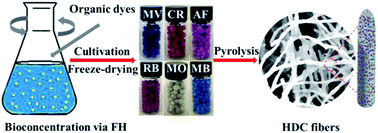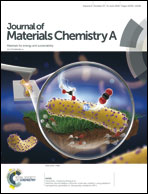Bioconcentration of organic dyes via fungal hyphae and their derived carbon fibers for supercapacitors†
Abstract
Heteroatom doping can change the electrochemical properties of carbon materials, but the simple, cheap and environmentally friendly preparation of these materials still remains a challenge. Herein, we have reported a new general strategy to fabricate heteroatom-doped carbon fiber materials based on the bioconcentration of different toxic organic dyes via fungal hyphae. The doped carbon fibers had a high content of heteroatoms and a three-dimensional network structure, exhibiting great potential as electrode materials for supercapacitors. Among these products, the N–S doped carbon fiber prepared by bioconcentration of methylene blue had the highest specific capacitance of 235 F g−1 at 1 A g−1 and good rate capability (72.8% retention from 1 A g−1 to 20 A g−1). This strategy can turn toxic waste into valuable materials, converting trash to treasure in the most literal sense; this bioconcentration method is green, general, low-cost and suitable for the preparation of fungal hyphae heteroatom-doped carbon fiber materials from different heteroatom precursors.



 Please wait while we load your content...
Please wait while we load your content...